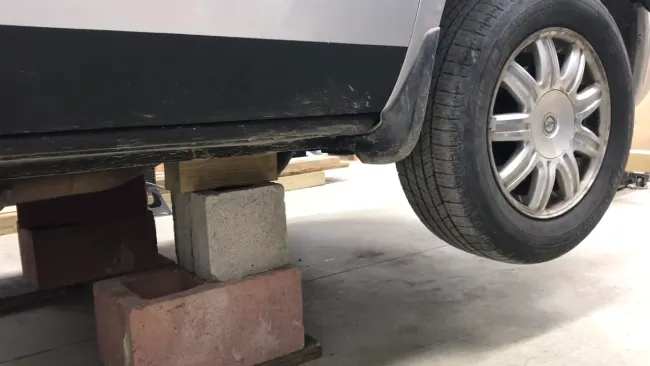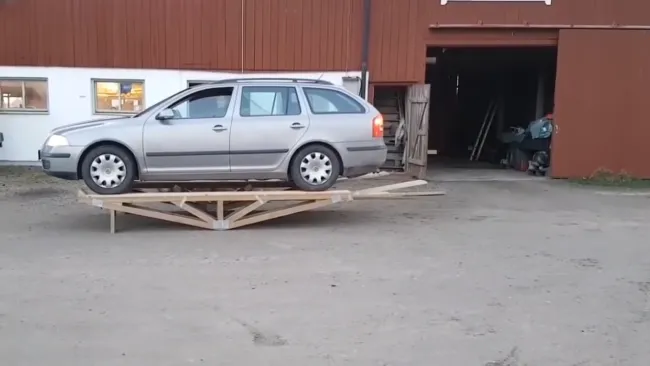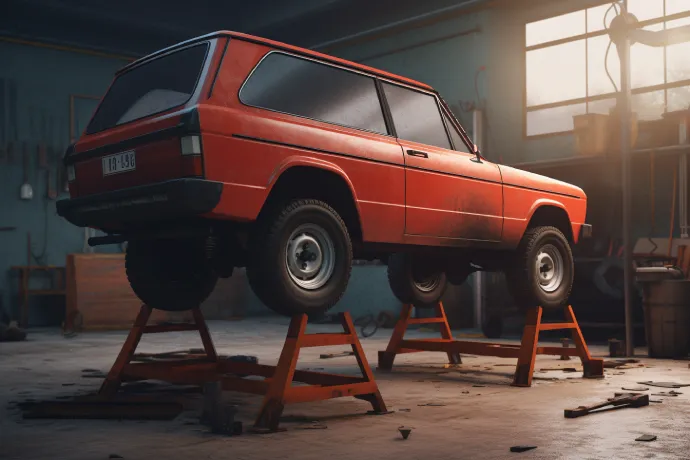Last Updated on June 10, 2023
You may have to fix your car without a lift in some cases. Are you feeling helpless and wondering how to do the job without a lift? While a car lift may seem like the most convenient and safe option to raise your vehicle, sometimes it’s not feasible.
It could be because of the cost, lack of space, or even the inconvenience of not having one readily available. Fortunately, nine alternative ways to raise a car without a lift exist.
You can use wood studs, steel ramps, oil change ramps, race ramps, jack stands, entry-level scissor-style lifts, the Kwik-Lift, mechanic’s creepers, and wheel cribs. Each of these alternatives has advantages and disadvantages, so choosing the one that’s right for your needs is essential.
So, let’s dive in and explore these alternative ways to raise a car without a lift.
How to Raise a Car Without a Lift: Nine Alternative Ways

If you’re looking for ways to raise your car without a lift, several options are available:
#1 Wood Studs
Grab a couple of wood studs and slide them under your ride. Watch as it effortlessly rises off the ground. Wood studs are a cheap and easy way to raise your car without a lift.
But remember that using wood studs can be risky. You need to make sure that the studs are of the right size and strength to support the weight of your car. If unsure, it’s better to go for a safer option.
#2 Steel Ramps
You’ve got options for elevating your vehicle, and steel ramps are a practical and safe choice. These ramps are made of heavy-duty steel and are designed to support the weight of your vehicle.
They are easy to use and can be set up in minutes. Simply place the ramps in front of your car’s wheels and drive up onto them. As you drive up, the back of the car will rise, allowing you to work on the underside of the vehicle.
One of the benefits of using steel ramps is that they’re much safer than using wood studs or other makeshift solutions. They’re designed to hold the weight of your vehicle and won’t slip or move around while you’re working on your car.
[Note: Steel ramps may not be suitable for low-body cars due to their steep slope and potential damage to the front bumper.]
#3 Oil Change Ramps
Slide your vehicle onto the simple and cost-effective oil change ramps for easy access to the underside without slipping on a smooth surface. These ramps are designed specifically for oil changes and routine maintenance, and they are made of durable plastic or rubber with a non-slip surface.
They’re also lightweight and easy to store, making them an ideal choice for those with limited space. When using oil change ramps, one thing to remember is that they have a limited weight capacity. Also, they may not be suitable for vehicles with low ground clearance, as they can raise the car quite high.
#4 Race Ramps
If you’re looking for a reliable and versatile way to elevate your vehicle for maintenance, race ramps may be the perfect solution. These ramps are made of durable, lightweight materials that make them easy to move and store.
Race ramps are also designed with safety in mind. With a pair, they can support up to 6,000 pounds and come in different sizes and shapes. Also, their non-slip surface provides excellent traction for your tires, and their low profile makes them easy to drive onto without damaging your car.
#5 Jack stands
You may be hesitant to use jack stands when working on your vehicle due to safety concerns. But don’t worry. With proper usage and placement, jack stands can provide a secure and stable platform for your vehicle.
To use jack stands safely, follow these steps:
- Begin by parking your vehicle on a flat and level surface, and engage the emergency brake.
- Use a floor jack to lift the vehicle, ensuring the weight is evenly distributed on the jack’s saddle.
- Place the jack stands beneath the vehicle’s designated lift points, lowering the vehicle onto the stands for support.
- Double-check that the jack stands are securely placed at the correct height before working on your vehicle.
When you’re finished, use the floor jack to lift the vehicle slightly and remove the jack stands, lowering the vehicle back to the ground.
#6 Entry-Level Scissor-Style Lifts
An entry-level scissor-style lift can be a convenient and safe option for lifting your vehicle during maintenance and repairs. However, scissor-style lifts still have some drawbacks. They have a lower weight capacity than other lifts and may not be suitable for larger vehicles or trucks.
Also, they need a smooth, flat surface to operate safely, so you might have issues if you don’t have a smooth garage or driveway. Even with these limitations, entry-level scissor-style lifts can be a great choice for people on a budget who need to lift their car.
#7 The Kwik-Lift
Discover the Kwik-Lift, a game-changing lifting option for those who want to raise their vehicles without a traditional lift. This lift offers adjustable compatibility and excellent lifting height and works well with low-ground clearance vehicles.
Unlike other lifts, the Kwik-Lift doesn’t require hydraulics or electricity, and it’s portable, making it easy to move from one location to another. Made in the USA with US steel, the Kwik-Lift is a safe and reliable way to do brake work.
#8 Mechanic’s Creepers
Explore an essential tool for anyone who wants to easily access the underside of their vehicle with ease and affordability: The Mechanic’s Creeper. These low-profile platforms with wheels are designed to allow mechanics to slide under cars and work on them without needing a lift.
They’re sturdy steel or plastic and can hold up to 350 pounds, making them ideal for working on cars, trucks, and SUVs. Mechanic’s creepers come in different styles and sizes to accommodate different needs and budgets.
#9 Wheel Cribs
With wheel cribs, you can easily elevate your vehicle for maintenance and create a safer working environment than with jacks or lifts. These DIY or prefabricated alternatives to jack stands are made of 2x4s or expanded foam and provide more stability as a lightweight lift solution.
They’re perfect for those who want to work on their car at home without investing in a car lift. With wheel cribs, you can have peace of mind knowing that your vehicle is securely elevated.
Here are three benefits of using wheel cribs:
- They provide a safer alternative to traditional jack stands.
- They’re lightweight and easy to store, making them ideal for home use.
- They’re cost-effective and can save you money in the long run.
Steps Involved in Lifting a Car When Not Using a Car Lift

When lifting your vehicle without a car lift, there are some steps you need to follow:
Step 1. Position the Car on a Level Surface
Ensure you find a flat surface to park your vehicle before you begin. This is crucial because an uneven surface can make it difficult to lift the car safely. If the car isn’t level, it can cause the jack to slip and potentially injure you or damage your car.
So, find a spot that is as level as possible, whether it’s your driveway, garage, or a nearby parking lot. Once you’ve found a level surface, you can position your car in the right spot for lifting.
Step 2. Engage the Parking Brake
Engaging the parking brake is like putting an anchor down, securing the car, and preventing it from rolling away. This is crucial when lifting your car without a lift because you don’t want it to move or shift while working underneath it.
To engage the parking brake, simply locate the lever or pedal near the driver’s seat and push it down or up. You’ll know it’s engaged when you feel resistance or hear a clicking sound.
Step 3. Lift the Vehicle With a Hydraulic Jack
Now comes the heart-pumping moment as you press down on the hydraulic jack handle and feel the vehicle’s weight slowly lift into the air. Ensure the jack is correctly positioned under the vehicle’s designated lifting points before lifting the vehicle.
Follow these tips to lift the vehicle safely:
- Place the hydraulic jack on a flat surface and ensure it’s stable.
- Turn the jack handle clockwise to lift the vehicle.
- Keep your hands and feet away from under the car while it’s being lifted.
- Check that the vehicle is lifted evenly.
- Lift the vehicle high enough to do the necessary work.
Step 4. Place Any Alternative Tool Under the Car
If you’ve safely raised your vehicle, it’s time to focus on choosing the right alternative tool for keeping it secure. This will give you the peace of mind to confidently tackle any maintenance or repairs.
One option is to use sturdy jack stands, which should be placed under the vehicle’s designated lift points. Place these stands on a solid surface, like a concrete floor, and adjust them to the same height before lowering the car.
Another alternative tool is a ramp, which can be driven onto and safely holds the vehicle in place. Ramps are often made of steel or plastic and should be positioned on a level surface.
Is it safe to lift a car without a car lift?

Although one of those methods is safe for lifting a car, working under it is not. Lifting a vehicle without a proper lift can be precarious and potentially perilous. Although there are various ways to lift a car without a lift, it’s crucial to understand the risks involved before attempting any of them.
Do alternative methods pose any risk of damaging the car?
If you lift your car without taking the right precautions and following the correct procedures, you could seriously damage it. Improperly raising your car can cause damage to its suspension, frame, or body. This can lead to costly repairs and even compromise your safety while driving.
Lifting a car without proper safety precautions can also cause injury or death if the car falls. Researching and following the manufacturer’s instructions for any lifting equipment is crucial to avoid damaging your car and putting yourself at risk.
Lifting Cars Without a Lift? Proceed with Caution and Safety First
Lifting a vehicle without a lift is possible, but planning and executing with caution and safety is important. Safety should always be the top priority, taking all necessary precautions to prevent damage to the car and yourself.
Several effective methods have been outlined previously, but use the appropriate equipment and follow instructions provided by the manufacturer. Remember that lifting vehicles without a lift can be risky and potentially dangerous.
Thus, exercising caution and ensuring all necessary safety measures are taken is critical. Some alternative methods may also cause damage to your car if misused.
